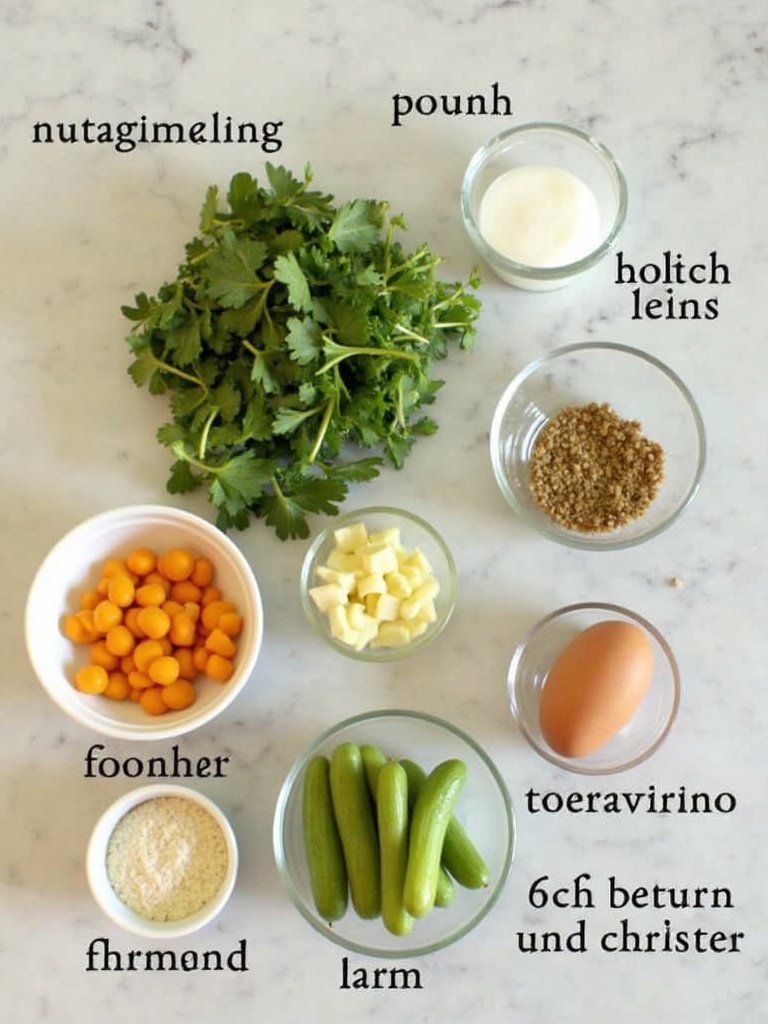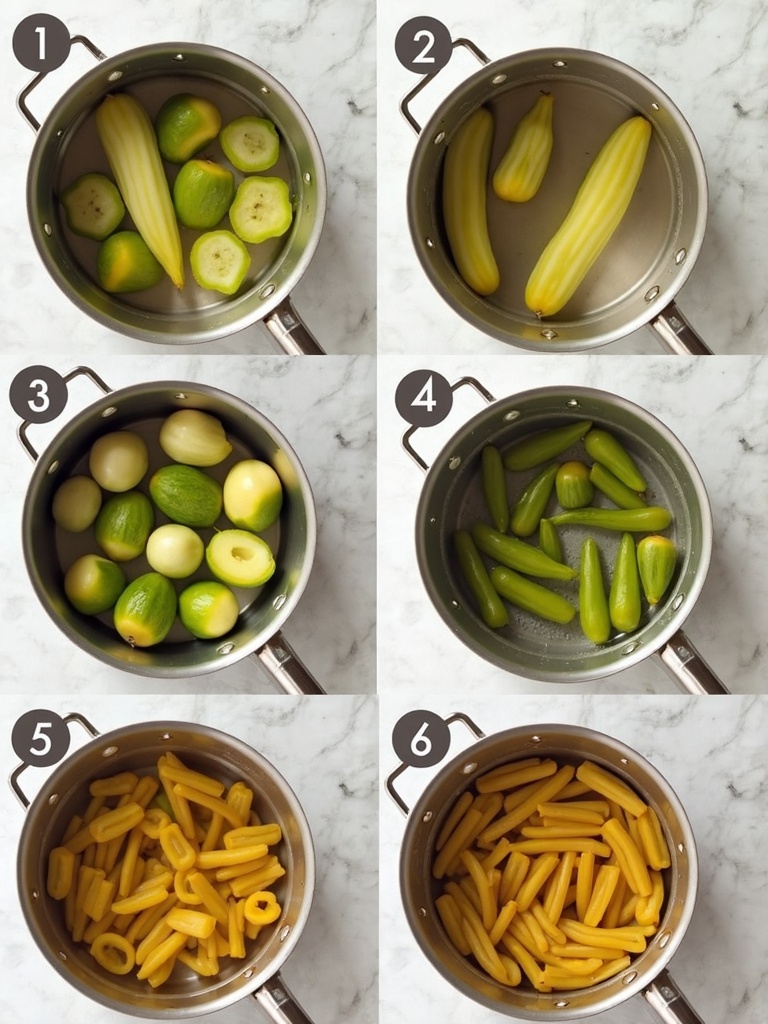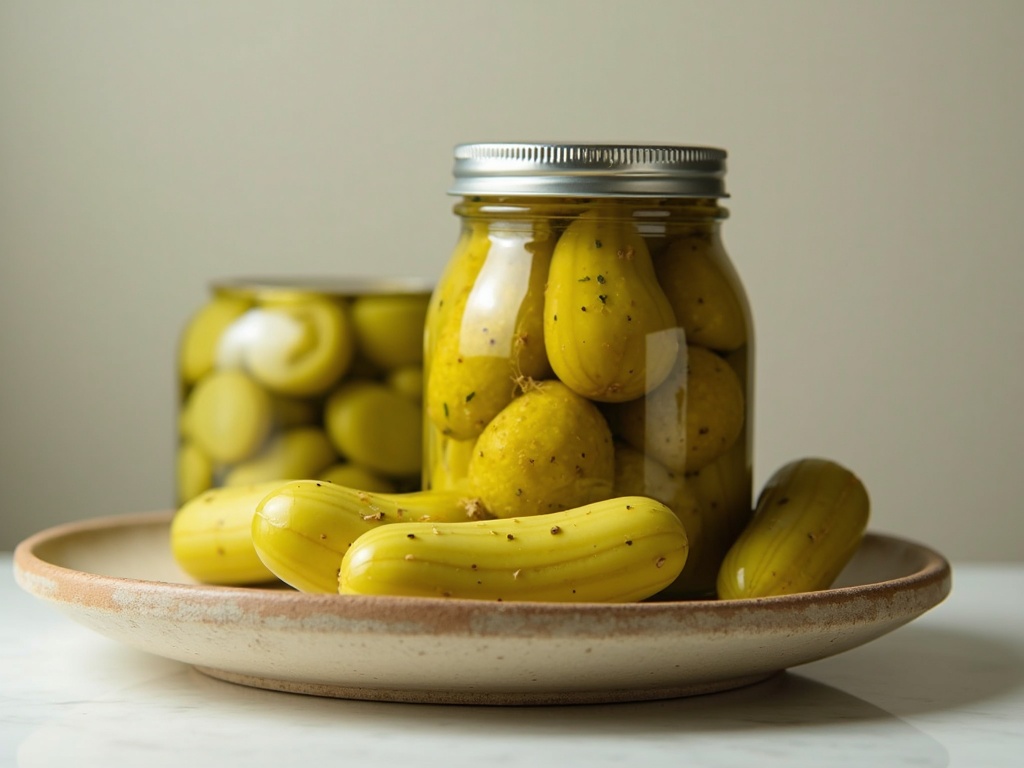Introduction
Looking for a quick and easy way to preserve fresh cucumbers? Refrigerator pickles are the perfect solution! Unlike traditional canning methods that require special equipment and processing, refrigerator pickles are made with a simple vinegar brine and stored in the refrigerator. These crisp, tangy pickles are ready to enjoy in just a few hours and stay fresh for weeks.
Find In This Article
Ingredients You Will Need

Creating delicious refrigerator pickles requires simple ingredients that you likely already have in your pantry. Here’s everything you’ll need to make these crisp and flavorful treats:
- 2 pounds of fresh pickling cucumbers (about 6-8 medium cucumbers)
- 1 large sweet onion, thinly sliced
- 4-6 garlic cloves, peeled and lightly crushed
- 2-3 sprigs of fresh dill (or 2 tablespoons dried dill weed)
- 2 cups white vinegar
- 2 cups water
- 3 tablespoons kosher salt (not iodized table salt)
- 2 tablespoons granulated sugar
- 2 teaspoons mustard seeds
- 1 teaspoon celery seeds
- 1 teaspoon coriander seeds
- 1/2 teaspoon red pepper flakes (adjust to taste)
- 1/2 teaspoon black peppercorns
Ingredient Substitutions:
- Apple cider vinegar can replace white vinegar for a milder, slightly sweeter flavor
- Sea salt can substitute for kosher salt (use about 2.5 tablespoons)
- Brown sugar works in place of white sugar for a deeper flavor
- Fresh herbs like tarragon or thyme can replace or accompany dill
- For extra color and flavor, add sliced bell peppers or pickled red onions to your jars
Timing
Making refrigerator pickles is remarkably quick compared to traditional pickles, which is one of their greatest advantages!
- Preparation Time: 20 minutes
- “Cooking” Time: 10 minutes (just for the brine)
- Initial Cooling Time: 30 minutes
- Refrigeration Before Eating: 4 hours minimum (though 24 hours is better)
- Total Active Time: 30 minutes
Interestingly, while traditional canned pickles take weeks to develop their flavor and require over 2 hours of processing time, these refrigerator pickles can be enjoyed the same day they’re made. That’s approximately 75% less waiting time than conventional pickling methods!
Step-by-Step Instructions

Step 1: Prepare Your Cucumbers
Wash your cucumbers thoroughly under cold running water. For the crispiest refrigerator pickles, choose firm, fresh pickling cucumbers without blemishes. Trim 1/8 inch off each end (especially the blossom end which contains enzymes that can soften pickles). Cut the cucumbers into your preferred shape—spears, coins, or chips all work beautifully.
Tip: If you’re using larger cucumbers, consider removing some of the seeds as they can make your pickles less crisp.
Step 2: Prepare Your Containers
Wash mason jars or glass containers with hot, soapy water and rinse thoroughly. You’ll need containers with about 2 quarts (64 ounces) of total capacity. Unlike traditional canning, sterilization isn’t strictly necessary for refrigerator pickles since they’ll be stored in the refrigerator, but clean containers are essential.
Tip: Wide-mouth jars make packing and retrieving pickles much easier.
Step 3: Pack Your Jars
Layer your cucumber pieces in the jars, interspersing with sliced onion, garlic cloves, fresh dill, and any other add-ins you desire. Pack them tightly but avoid crushing them. Leave about 1/2 inch of headspace at the top of each jar.
Tip: Alternate cucumber spears with tips up and down to maximize space in your jars.
Step 4: Prepare the Brine
In a medium saucepan, combine water, vinegar, sugar, salt, mustard seeds, celery seeds, coriander seeds, red pepper flakes, and black peppercorns. Bring the mixture to a gentle boil over medium-high heat, stirring until the salt and sugar completely dissolve (about 3-5 minutes).
Tip: For extra flavor depth, toast your spices in the dry saucepan for 30 seconds before adding the liquid ingredients.
Step 5: Pour the Hot Brine
Carefully pour the hot brine over the cucumbers in the jars, ensuring that all produce is completely covered. Leave about 1/4 inch of headspace. Tap the jars gently against the counter to release any trapped air bubbles.
Tip: Use a funnel to pour the brine for less mess and more precision.
Step 6: Seal and Cool
Secure the lids tightly on your jars and allow them to cool to room temperature (about 30 minutes). This cooling period helps the cucumbers begin absorbing the flavors of your brine.
Tip: Label your jars with the date – even though these will disappear quickly, it’s good to track freshness!
Step 7: Refrigerate
Place the sealed jars in the refrigerator. While your refrigerator pickles will have some flavor after just 4 hours, they reach their peak flavor after about 24-48 hours as the brine fully penetrates the cucumbers.
Tip: Gently turn the jars upside down once or twice during the first day to ensure even distribution of spices and flavors.

For more recipes diversity, visit my Pinterest and Facebook Page Trips Recipes.
Nutritional Information
Refrigerator pickles are a flavorful addition to meals with relatively low nutritional impact. Here’s what you can expect per 1/4 cup serving (approximately 4 pickle spears):
- Calories: 12-15 calories
- Carbohydrates: 3g
- Sugars: 2g
- Sodium: 240mg (varies based on salt used)
- Fat: 0g
- Protein: 0g
- Fiber: 1g
- Vitamin K: 12% of daily value
- Vitamin A: 4% of daily value
Data insights: Compared to store-bought pickles, homemade refrigerator pickles typically contain 25% less sodium and no artificial preservatives, colors, or flavors.
Healthier Alternatives for the Recipe
Want to make your refrigerator pickles even healthier? Try these modifications:
- Reduce the sugar content or replace with honey or monk fruit sweetener for a lower glycemic option
- Use Himalayan pink salt which contains additional trace minerals compared to regular salt
- Add turmeric (1/2 teaspoon) to the brine for anti-inflammatory benefits
- Incorporate more garlic for its heart-healthy compounds
- Try fermenting your pickles instead, which creates beneficial probiotics (though this is technically a different recipe than quick refrigerator pickles)
- Add a splash of raw, unfiltered apple cider vinegar with the mother for probiotic benefits
- Use sea salt instead of kosher salt for additional minerals
- Add fresh ginger slices for digestive benefits
Serving Suggestions
Your crisp, flavorful refrigerator pickles complement numerous dishes. Here are some delicious ways to enjoy them:
- Serve alongside sandwiches and burgers as the perfect crunchy side
- Chop finely and add to tuna, egg, or chicken salad for extra tang and texture
- Include on charcuterie boards with cheeses and cured meats
- Add to grain bowls or salads for a zesty crunch
- Dice and mix into potato salad or macaroni salad
- Serve with fried chicken or fish for a palate-cleansing side
- Add to tacos or pulled pork sandwiches for brightness
- Blend into homemade tartar sauce or remoulade
- Chop and add to deviled egg filling for extra zing
- Serve as part of a relish tray at gatherings
Common Mistakes to Avoid
Even something as simple as refrigerator pickles has potential pitfalls. Here’s how to avoid them:
- Using table salt instead of kosher salt or sea salt (table salt has anti-caking agents that cloud the brine)
- Forgetting to trim the blossom end of the cucumber, which contains enzymes that soften pickles
- Using old or soft cucumbers (firm, fresh cucumbers yield the crispiest pickles)
- Not completely submerging the cucumbers in brine (exposed portions can mold)
- Using reactive metal containers or utensils that can interact with vinegar (stick with glass, ceramic, or plastic)
- Opening and closing the jar frequently, which introduces bacteria and shortens shelf life
- Expecting the flavor of refrigerator pickles to match fermented pickles (they’re different preparation methods with distinct flavor profiles)
- Using cloudy or unfiltered vinegar, which can make your brine appear murky
- Overcrowding your jars, which prevents proper brine circulation
- Not allowing enough time for the flavors to develop (patience yields tastier pickles!)
Storing Tips for the Recipe
Proper storage ensures your refrigerator pickles remain fresh and delicious:
- Always store in the refrigerator (unlike canned pickles, these aren’t shelf-stable)
- Keep for up to 2 months in the refrigerator (though they’re typically at peak flavor for the first 3-4 weeks)
- Use clean utensils when retrieving pickles to prevent introducing bacteria
- Keep the pickles fully submerged in the brine for maximum preservation
- Tighten lids securely after each use to maintain freshness
- If the brine becomes cloudy or the pickles develop an off smell, discard immediately
- Avoid freezing refrigerator pickles as they’ll lose their crisp texture when thawed
- Consider making smaller batches more frequently for optimal freshness
- Use small jars if you won’t consume them quickly once opened
Conclusion
Refrigerator pickles truly represent the perfect balance of simplicity and satisfaction in home food preservation. Without specialized equipment or extensive time commitments, you can transform fresh cucumbers into crisp, flavorful pickles that rival any store-bought variety. The beauty of this method lies in its flexibility—customize the spices, adjust the sweetness or heat, and create a pickle that perfectly suits your palate.
I encourage you to experiment with this basic recipe. Try different herb combinations, add unique spices, or even pickle other vegetables using the same brine. The refrigeration method opens up countless possibilities for quick preserving throughout the growing season.
Remember, the joy of making refrigerator pickles isn’t just in the eating—it’s in the process of transforming simple ingredients into something special, connecting with seasonal produce, and sharing your creations with friends and family. So grab those cucumbers and get pickling—your taste buds will thank you!
FAQs
How long do refrigerator pickles last?
Refrigerator pickles typically last 1-2 months when properly stored in the refrigerator. Unlike shelf-stable canned pickles, these are designed for cold storage only and should never be kept at room temperature for extended periods.
Do I need special pickling cucumbers for refrigerator pickles?
While pickling cucumbers (like Kirby) produce the crispest refrigerator pickles, regular slicing cucumbers will work too. Just be aware they may have more seeds and slightly softer texture. English cucumbers also work well but will yield a different texture.
Why did my refrigerator pickles turn out soggy?
Soggy refrigerator pickles usually result from not trimming the blossom end of the cucumber (which contains softening enzymes), using overripe cucumbers, or not keeping them cold enough. Adding a grape leaf or 1/4 teaspoon of alum to your jars can help maintain crispness.
Can I reuse the pickle brine?
Yes, you can reuse refrigerator pickle brine once or twice for new batches. Bring it to a boil first to ensure food safety, then pour over fresh cucumbers. The flavor may be slightly less intense with each reuse.
Are refrigerator pickles probiotic like fermented pickles?
No, refrigerator pickles are preserved with vinegar rather than fermentation, so they don’t contain the beneficial probiotics found in naturally fermented pickles. However, they’re much quicker to make and still offer great flavor.
Why shouldn’t I use table salt for pickling?
Table salt contains anti-caking agents and iodine that can make your pickle brine cloudy and potentially affect the flavor. Kosher salt or pickling salt are preferred for clear brine and clean flavor in refrigerator pickles.
Can I make refrigerator pickles without sugar?
Absolutely! The sugar in refrigerator pickles is primarily for flavor balance and can be reduced, eliminated, or substituted with honey, stevia, or monk fruit sweetener according to your preference.
Why are my refrigerator pickles too salty/vinegary?
If your refrigerator pickles taste too strong, they might need more time for the flavors to balance, or your cucumber-to-brine ratio might be off. You can dilute too-strong brine with a bit of water, or for future batches, adjust salt and vinegar levels to your taste.

Homemade Refrigerator Pickles
- Total Time: PT30M
- Yield: 2 quarts
- Diet: Vegan
Description
Quick and easy refrigerator pickles that stay crisp and flavorful for weeks.
Ingredients
-
- 2 pounds of fresh pickling cucumbers (about 6–8 medium cucumbers)
-
- 1 large sweet onion, thinly sliced
-
- 4–6 garlic cloves, peeled and lightly crushed
-
- 2–3 sprigs of fresh dill (or 2 tablespoons dried dill weed)
-
- 2 cups white vinegar
-
- 2 cups water
-
- 3 tablespoons kosher salt (not iodized table salt)
-
- 2 tablespoons granulated sugar
-
- 2 teaspoons mustard seeds
-
- 1 teaspoon celery seeds
-
- 1 teaspoon coriander seeds
-
- 1/2 teaspoon red pepper flakes (adjust to taste)
-
- 1/2 teaspoon black peppercorns
Instructions
1. Wash cucumbers thoroughly and trim 1/8 inch off each end. Slice into spears, coins, or chips. For larger cucumbers, remove some seeds to maintain crispness.
2. Clean mason jars or glass containers with hot, soapy water. You’ll need about 2 quarts of total capacity. Wide-mouth jars are best for easy packing and removal.
3. Tightly pack cucumber pieces into jars with sliced onion, garlic, dill, or other desired add-ins, leaving about 1/2 inch of headspace.
4. In a saucepan, combine water, vinegar, sugar, salt, mustard seeds, celery seeds, coriander, red pepper flakes, and peppercorns. Bring to a gentle boil and stir until dissolved.
5. Pour the hot brine over the packed jars, ensuring all contents are submerged. Leave about 1/4 inch of headspace and tap jars gently to release air bubbles.
6. Seal the jars and let them cool at room temperature for 30 minutes. This begins the flavor absorption process.
7. Refrigerate the jars. Pickles can be enjoyed after 4 hours, but peak flavor develops after 24–48 hours.
Notes
These no-cook refrigerator pickles are ready to eat in just hours and make a perfect condiment or snack.
- Prep Time: PT20M
- Cook Time: PT10M
- Category: Condiment
- Method: Pickling
- Cuisine: American
